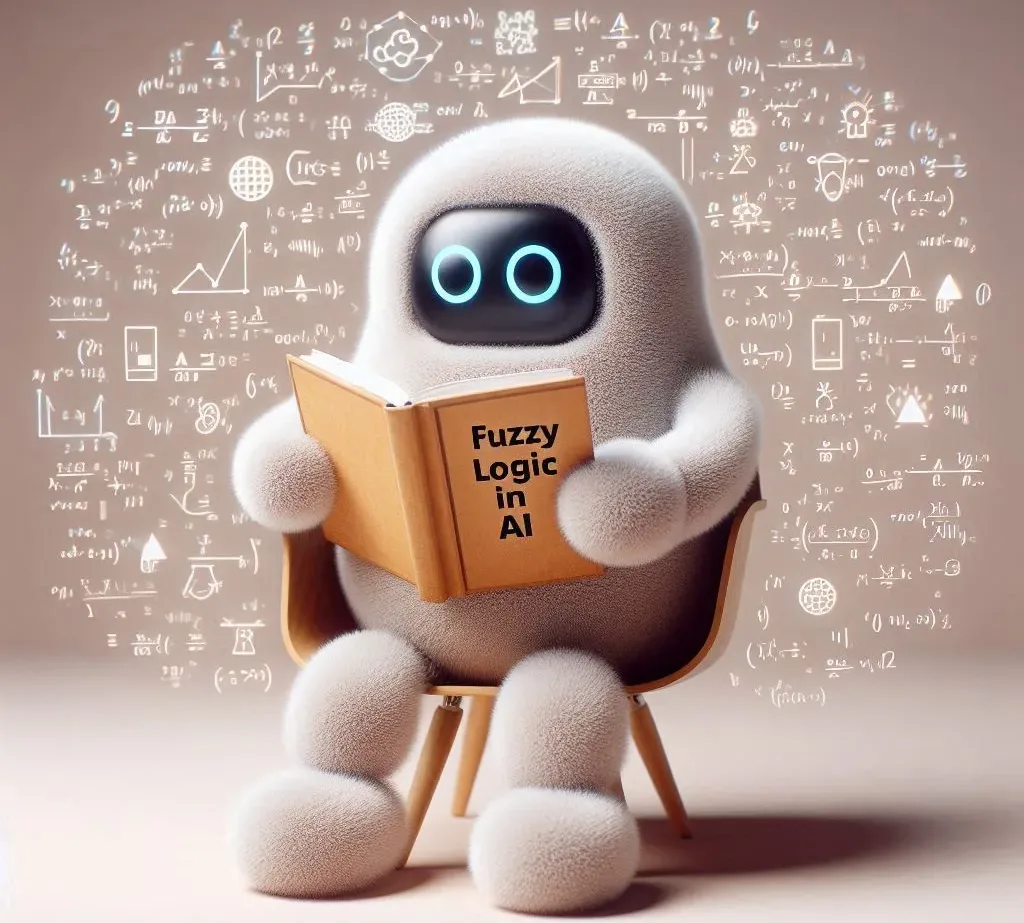Fuzzy logic, a concept introduced by Lotfi Zadeh in 1965, revolutionized the way we approach problem-solving in artificial intelligence. Unlike traditional binary logic, which deals with crisp values of true or false, fuzzy logic embraces the nuances of real-world scenarios. It allows for degrees of truth, making it an invaluable tool in AI systems that must navigate ambiguity and uncertainty.
At its core, fuzzy logic mimics human reasoning. We often make decisions based on imprecise or incomplete information, and fuzzy logic provides a mathematical framework to model this process. This makes it particularly useful in AI applications where rigid, black-and-white distinctions fall short.
The Basics of Fuzzy Sets
To understand fuzzy logic, we must first grasp the concept of fuzzy sets. In classical set theory, an element either belongs to a set or it doesn’t. Fuzzy sets, however, allow for partial membership. Each element in a fuzzy set has a degree of membership, typically represented by a value between 0 and 1.
For example, consider the concept of “tall” for human height. In classical logic, we might define “tall” as anyone over 6 feet. But this creates a sharp boundary – someone 5’11” is not tall, while someone 6’0″ is. Fuzzy logic allows for a more natural representation. A person who is 5’8″ might have a membership of 0.3 in the “tall” set, while someone who is 6’2″ might have a membership of 0.9.
Fuzzy Logic Operations
Fuzzy logic extends traditional logical operations to work with these partial truths. The basic operations include:
- Fuzzy AND (intersection): min(A, B)
- Fuzzy OR (union): max(A, B)
- Fuzzy NOT (complement): 1 – A
These operations allow us to combine and manipulate fuzzy sets, forming the basis for more complex fuzzy systems.
Fuzzy Inference Systems
A key application of fuzzy logic in AI is the fuzzy inference system (FIS). This system takes crisp input values, applies fuzzy logic operations, and produces crisp output values. The process typically involves four steps:
- Fuzzification: Convert crisp inputs into fuzzy values
- Rule evaluation: Apply fuzzy rules to the fuzzified inputs
- Aggregation: Combine the results of all rules
- Defuzzification: Convert the aggregated fuzzy output back to a crisp value
Let’s explore each of these steps in more detail.
Fuzzification
In this step, we take crisp input values and determine their degree of membership in various fuzzy sets. This is done using membership functions, which define how each point in the input space is mapped to a membership value between 0 and 1.
Common shapes for membership functions include triangular, trapezoidal, and Gaussian curves. The choice of membership function depends on the specific application and the nature of the input data.
Rule Evaluation
Once we have fuzzified inputs, we apply a set of if-then rules. These rules are typically defined by domain experts and capture the relationships between different fuzzy sets. For example:
IF temperature IS hot AND humidity IS high THEN comfort IS low
The antecedents (the “if” part) are combined using fuzzy operations like AND or OR, and the consequent (the “then” part) is inferred based on the rule’s strength.
Aggregation
After evaluating all rules, we combine their outputs into a single fuzzy set. This aggregation step typically uses the fuzzy OR operation to merge the consequences of all applicable rules.
Defuzzification
The final step converts the aggregated fuzzy output back into a crisp value. Several methods exist for defuzzification, with the centroid method being one of the most common. This method calculates the center of gravity of the aggregated fuzzy set to determine the final crisp output.
Advanced Concepts in Fuzzy Logic
As we delve deeper into fuzzy logic, several advanced concepts emerge that enhance its power and flexibility in AI applications.
Type-2 Fuzzy Sets
Traditional fuzzy sets, also known as Type-1 fuzzy sets, assign a single membership value to each element. Type-2 fuzzy sets take this a step further by allowing the membership value itself to be fuzzy. This introduces an additional dimension of uncertainty, making Type-2 fuzzy systems particularly useful in handling noisy or imprecise data.
In a Type-2 fuzzy set, the membership function is three-dimensional. The additional dimension, called the secondary membership, represents the uncertainty in the primary membership value. This allows for more nuanced modeling of complex systems where the degree of fuzziness itself is uncertain.
Adaptive Neuro-Fuzzy Inference Systems (ANFIS)
ANFIS combines the learning capabilities of neural networks with the interpretability of fuzzy logic. This hybrid approach allows the system to automatically tune fuzzy inference systems using training data.
In an ANFIS, the fuzzy inference system is represented as a multi-layer feedforward network. The network’s structure mirrors the steps of fuzzy inference, with layers for fuzzification, rule evaluation, and defuzzification. The system can then be trained using backpropagation or hybrid learning algorithms to optimize its parameters.
This combination of neural networks and fuzzy logic creates a powerful tool for modeling complex, nonlinear relationships in data while maintaining the interpretability of fuzzy rules.
Practical Applications of Fuzzy Logic in AI
Fuzzy logic finds applications across a wide range of AI domains. Let’s explore some concrete examples:
Control Systems
One of the most successful applications of fuzzy logic is in control systems. Fuzzy controllers can handle complex, nonlinear systems that are difficult to model using traditional control theory.
For example, in an autonomous vehicle, a fuzzy logic controller might manage the braking system. Inputs like vehicle speed, obstacle distance, and road conditions are fuzzified and processed through a set of rules to determine the appropriate braking force.
Pattern Recognition and Image Processing
Fuzzy logic excels in handling the ambiguity inherent in many pattern recognition tasks. In image processing, fuzzy techniques can be used for edge detection, image segmentation, and noise reduction.
For instance, a fuzzy edge detection algorithm might use fuzzy sets to represent concepts like “edge strength” and “edge direction,” allowing for more robust detection in noisy or low-contrast images.
Natural Language Processing
The inherent ambiguity of human language makes it a natural fit for fuzzy logic approaches. Fuzzy techniques can be used in sentiment analysis, text classification, and machine translation.
In sentiment analysis, for example, fuzzy sets can represent degrees of positive or negative sentiment, allowing for more nuanced classification of text beyond simple binary categories.
Expert Systems
Fuzzy logic shines in expert systems where human knowledge needs to be encoded into a decision-making system. Medical diagnosis is a prime example. A fuzzy expert system for diagnosing heart disease might use fuzzy sets to represent symptoms and risk factors, with rules derived from medical expertise to infer the likelihood of various conditions.
Programming Examples
Let’s look at some Python code examples to illustrate how fuzzy logic concepts can be implemented:
Example 1: Simple Fuzzy Set and Operations
“`python
import numpy as np
import matplotlib.pyplot as plt
def triangular_membership(x, a, b, c):
return np.maximum(np.minimum((x - a) / (b - a), (c - x) / (c - b)), 0)
x = np.linspace(0, 10, 1000)
young = triangular_membership(x, 0, 2, 4)
middle_aged = triangular_membership(x, 3, 5, 7)
old = triangular_membership(x, 6, 8, 10)
plt.plot(x, young, label='Young')
plt.plot(x, middle_aged, label='Middle-aged')
plt.plot(x, old, label='Old')
plt.legend()
plt.title('Fuzzy Sets for Age')
plt.xlabel('Age')
plt.ylabel('Membership Degree')
plt.show()
# Fuzzy AND operation
fuzzy_and = np.minimum(young, middle_aged)
plt.plot(x, fuzzy_and, label='Young AND Middle-aged')
plt.legend()
plt.title('Fuzzy AND Operation')
plt.xlabel('Age')
plt.ylabel('Membership Degree')
plt.show()This example defines fuzzy sets for age categories and demonstrates the fuzzy AND operation.
Example 2: Simple Fuzzy Inference System
“`python
import numpy as np
import skfuzzy as fuzz
from skfuzzy import control as ctrl
# Antecedent/Consequent objects
temperature = ctrl.Antecedent(np.arange(0, 101, 1), 'temperature')
humidity = ctrl.Antecedent(np.arange(0, 101, 1), 'humidity')
fan_speed = ctrl.Consequent(np.arange(0, 101, 1), 'fan_speed')
# Fuzzy sets
temperature['cold'] = fuzz.trimf(temperature.universe, [0, 0, 50])
temperature['warm'] = fuzz.trimf(temperature.universe, [0, 50, 100])
temperature['hot'] = fuzz.trimf(temperature.universe, [50, 100, 100])
humidity['low'] = fuzz.trimf(humidity.universe, [0, 0, 50])
humidity['medium'] = fuzz.trimf(humidity.universe, [0, 50, 100])
humidity['high'] = fuzz.trimf(humidity.universe, [50, 100, 100])
fan_speed['low'] = fuzz.trimf(fan_speed.universe, [0, 0, 50])
fan_speed['medium'] = fuzz.trimf(fan_speed.universe, [0, 50, 100])
fan_speed['high'] = fuzz.trimf(fan_speed.universe, [50, 100, 100])
# Fuzzy rules
rule1 = ctrl.Rule(temperature['hot'] & humidity['high'], fan_speed['high'])
rule2 = ctrl.Rule(temperature['warm'] & humidity['medium'], fan_speed['medium'])
rule3 = ctrl.Rule(temperature['cold'] | humidity['low'], fan_speed['low'])
# Control System Creation and Simulation
fan_ctrl = ctrl.ControlSystem([rule1, rule2, rule3])
fan_simulation = ctrl.ControlSystemSimulation(fan_ctrl)
# Input values
fan_simulation.input['temperature'] = 80
fan_simulation.input['humidity'] = 70
# Compute output
fan_simulation.compute()
print(f"Fan speed output: {fan_simulation.output['fan_speed']}")
fan_speed.view(sim=fan_simulation)
plt.show()This example implements a simple fuzzy inference system for controlling fan speed based on temperature and humidity.
Conclusion: Fuzzy logic stands as a powerful tool in the AI toolkit, bridging the gap between human reasoning and machine intelligence. Its ability to handle uncertainty and imprecision makes it invaluable in a wide range of applications, from control systems to natural language processing.
As AI continues to evolve, fuzzy logic will likely play an increasingly important role in developing more nuanced and human-like artificial intelligence systems. By embracing the shades of gray in a world often viewed in black and white, fuzzy logic opens up new possibilities for creating intelligent systems that can navigate the complexities of the real world.
Whether you’re a beginner just starting to explore AI concepts or an advanced practitioner looking to enhance your systems, understanding and applying fuzzy logic can significantly expand your capabilities in artificial intelligence development.




